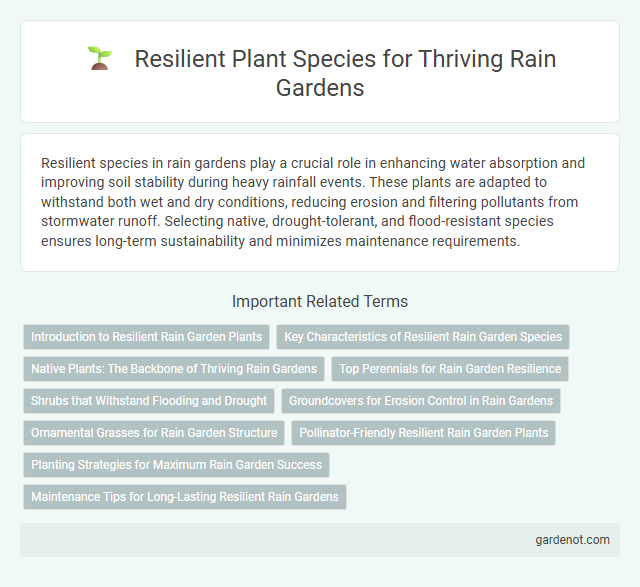Resilient species in rain gardens play a crucial role in enhancing water absorption and improving soil stability during heavy rainfall events. These plants are adapted to withstand both wet and dry conditions, reducing erosion and filtering pollutants from stormwater runoff. Selecting native, drought-tolerant, and flood-resistant species ensures long-term sustainability and minimizes maintenance requirements.
Introduction to Resilient Rain Garden Plants
Resilient rain garden plants, such as native sedges, rushes, and wildflowers, thrive in fluctuating moisture levels while improving stormwater absorption and soil filtration. These species possess deep root systems that prevent erosion and support local biodiversity by providing habitat for pollinators and beneficial insects. Selecting drought-tolerant and flood-resistant plants ensures the long-term effectiveness and ecological balance of rain gardens in urban and suburban environments.
Key Characteristics of Resilient Rain Garden Species
Resilient rain garden species exhibit deep root systems that enhance soil infiltration and prevent erosion during heavy rainfall. These plants demonstrate high tolerance to both drought and water saturation, enabling survival through fluctuating moisture conditions. Native species with adaptive traits such as fast growth and pest resistance contribute to the long-term stability and ecological function of rain gardens.
Native Plants: The Backbone of Thriving Rain Gardens
Native plants, such as switchgrass (Panicum virgatum) and blueflag iris (Iris versicolor), form the backbone of resilient rain gardens by enhancing stormwater absorption and soil stabilization. These species inherently adapt to local climate and soil conditions, promoting biodiversity and supporting pollinators like bees and butterflies. Incorporating native plants reduces maintenance needs while improving the rain garden's ability to withstand drought and flooding events.
Top Perennials for Rain Garden Resilience
Top perennials for rain garden resilience include Switchgrass (Panicum virgatum), Purple Coneflower (Echinacea purpurea), and Blue Flag Iris (Iris versicolor), all known for their strong drought and flood tolerance. These species enhance rain garden functionality by stabilizing soil, filtering pollutants, and supporting diverse pollinators, improving overall ecosystem health. Incorporating native perennials like Joe-Pye Weed (Eutrochium purpureum) and Black-eyed Susan (Rudbeckia hirta) further boosts resilience against extreme weather while requiring minimal maintenance.
Shrubs that Withstand Flooding and Drought
Resilient shrubs suitable for rain gardens include Redtwig Dogwood (Cornus sericea), which thrives in saturated soils and tolerates drought once established, and Buttonbush (Cephalanthus occidentalis), known for its flood tolerance and adaptability to dry periods. These species contribute to flood mitigation and erosion control while enhancing biodiversity by providing habitat for pollinators and birds. Optimal selection of native shrubs like Spicebush (Lindera benzoin) ensures sustainability and long-term resilience in fluctuating moisture conditions.
Groundcovers for Erosion Control in Rain Gardens
Resilient groundcovers such as creeping thyme, sedum, and creeping juniper provide effective erosion control in rain gardens by stabilizing soil with their extensive root systems. These species tolerate varying moisture levels and compacted conditions, making them ideal for absorbing stormwater and preventing runoff. Selecting native groundcovers enhances biodiversity while maintaining the structural integrity of rain gardens under fluctuating environmental stresses.
Ornamental Grasses for Rain Garden Structure
Ornamental grasses like Purple Muhly (Muhlenbergia capillaris) and Switchgrass (Panicum virgatum) provide structural resilience in rain gardens by tolerating fluctuating moisture levels and stabilizing soil with deep root systems. These species enhance the garden's ecological function by supporting water filtration and reducing erosion during storm events. Their adaptive growth patterns and seasonal color changes also contribute to year-round visual interest and habitat diversity.
Pollinator-Friendly Resilient Rain Garden Plants
Pollinator-friendly resilient rain garden plants such as Echinacea purpurea, Asclepias tuberosa, and Rudbeckia hirta thrive in fluctuating moisture levels while supporting bees, butterflies, and hummingbirds. These native perennials adapt to both wet and dry conditions, enhancing biodiversity and improving stormwater management. Selecting diverse, drought-tolerant species ensures a sustainable, vibrant rain garden that bolsters pollinator populations year-round.
Planting Strategies for Maximum Rain Garden Success
Selecting resilient species like native sedges, rushes, and wildflowers enhances rain garden durability by tolerating fluctuating moisture levels and local climate conditions. Strategic planting involves grouping species based on hydrological zones--wet-tolerant plants in low areas and drought-resistant species in uplands--to optimize water absorption and soil stability. Incorporating deep-rooted perennials improves soil structure and promotes effective pollutant filtration, maximizing the ecological function of the rain garden.
Maintenance Tips for Long-Lasting Resilient Rain Gardens
Select drought-tolerant and native plant species such as switchgrass, coneflowers, and sedges to enhance the resilience of rain gardens against variable weather conditions. Regularly inspect and remove invasive species, and mulch with organic materials to retain soil moisture and suppress weeds. Implement seasonal pruning and monitor soil health to sustain plant vigor and ensure efficient stormwater absorption over time.
Resilient species Infographic

 gardenot.com
gardenot.com